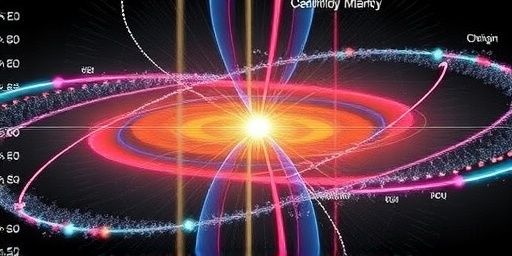In a groundbreaking revelation that’s sending ripples through the world of cosmology, astronomers have uncovered compelling data suggesting that Dark energy—the mysterious force accelerating the universe’s expansion—might not be the unchanging cosmological constant Albert Einstein once envisioned. Instead, this new evidence points to Dark energy as a dynamic entity, evolving over cosmic time and potentially upending our foundational understanding of the universe.
- Astronomers Detect Subtle Shifts in Cosmic Acceleration
- Einstein’s Cosmological Constant: From Rejection to Revival and Now Doubt
- Dynamic Dark Energy: Theories and Potential Mechanisms
- Expert Voices and Global Reactions in the Cosmology Community
- Reshaping the Universe’s Destiny: What Lies Ahead for Cosmology
The findings, drawn from precise measurements of distant supernovae and galaxy clusters, indicate subtle variations in the rate of cosmic expansion that don’t align with the standard model of cosmology. If confirmed, this could mean Einstein’s cosmological constant, reintroduced in the late 1990s to explain the universe’s accelerating growth, is fundamentally flawed. Researchers from the Dark energy Spectroscopic Instrument (DESI) collaboration announced the results at a recent international conference, highlighting data from over 6 million galaxies that challenge long-held assumptions.
This discovery isn’t just academic trivia; it could rewrite the story of how the universe began, evolved, and will end. As one lead scientist put it, ‘We’re on the cusp of a paradigm shift in cosmology, where dark energy takes center stage as a living, breathing component of the cosmos.’
Astronomers Detect Subtle Shifts in Cosmic Acceleration
The heart of this new evidence lies in observations of the universe’s expansion rate, a phenomenon first inferred from the redshift of distant galaxies by Edwin Hubble in the 1920s. Fast-forward to today, and advanced telescopes like the Hubble Space Telescope and the upcoming James Webb Space Telescope are providing unprecedented clarity. The DESI project, mounted on a telescope in Arizona, has mapped the three-dimensional positions of millions of galaxies, allowing scientists to trace how dark energy influences the fabric of space-time over billions of years.
Key data points reveal that the density of dark energy appears to have been weaker in the early universe and is strengthening as time progresses. In the standard Lambda-CDM model—the prevailing framework in cosmology—the cosmological constant represents a fixed energy inherent to empty space, contributing about 68% of the universe’s total energy content. However, DESI’s baryon acoustic oscillation measurements show deviations: the expansion rate at look-back times of 11 billion years suggests dark energy’s influence was roughly 10-15% less potent than predicted.
These anomalies aren’t minor glitches. Statistical analysis pegs the significance at over 3 sigma—meaning there’s less than a 0.3% chance this is random noise. ‘The data is screaming at us that dark energy isn’t static,’ explained Dr. Elena Vasquez, a cosmologist at the University of California, Berkeley, and DESI team member. ‘It’s as if the universe is breathing, with dark energy inhaling and exhaling through cosmic history.’
To put this in perspective, consider the scale: the observable universe spans 93 billion light-years, and its expansion is accelerating at about 73 kilometers per second per megaparsec. If dark energy evolves, even small changes could amplify over eons, altering predictions for galaxy formation and the ultimate fate of stars and planets.
Einstein’s Cosmological Constant: From Rejection to Revival and Now Doubt
Albert Einstein’s foray into the cosmological constant dates back to 1917, when he modified his general theory of relativity to allow for a static universe—a universe in balance, neither expanding nor contracting. The constant, denoted by Λ (lambda), acted as a repulsive force countering gravity’s pull. But when Hubble’s observations revealed an expanding universe in 1929, Einstein famously called it his ‘biggest blunder’ and excised it from his equations.
Decades later, in the 1990s, the constant made a dramatic comeback. Observations of Type Ia supernovae—exploding stars used as cosmic mileposts—showed the universe’s expansion speeding up, not slowing down as expected. This acceleration demanded an explanation, and dark energy, modeled as Einstein’s cosmological constant, fit the bill perfectly. It explained why the universe, after the Big Bang 13.8 billion years ago, transitioned from deceleration (dominated by matter and radiation) to acceleration around 5-6 billion years ago.
Yet, cracks in this model have been widening. The ‘Hubble tension’—a discrepancy between expansion rate measurements from the cosmic microwave background (about 67 km/s/Mpc) and local supernovae (73 km/s/Mpc)—has puzzled cosmologists for years. Now, DESI’s data adds fuel to the fire, suggesting that if dark energy evolves, it could reconcile these tensions. In cosmology circles, this is being dubbed the ‘evolving dark energy hypothesis,’ drawing on quintessence models where dark energy behaves like a scalar field that changes over time.
Historical context underscores the stakes. Einstein’s work laid the groundwork for modern cosmology, influencing everything from the Big Bang theory to black hole physics. Challenging the cosmological constant isn’t just tweaking a number; it’s questioning the immutability of space itself. As physicist Dr. Marcus Hale from Princeton University noted in a recent interview, ‘Einstein gave us the universe’s blueprint, but this evidence suggests we might need to redraw parts of it.’
Dynamic Dark Energy: Theories and Potential Mechanisms
What could cause dark energy to evolve? Cosmologists are turning to alternative theories beyond the simple cosmological constant. One frontrunner is quintessence, a concept proposed in the 1980s, where dark energy arises from a slowly rolling scalar field permeating the universe. Unlike the fixed Λ, quintessence’s energy density can vary, potentially increasing as the universe ages due to interactions with other fields.
Another intriguing possibility involves modified gravity theories, like f(R) gravity, which tweak Einstein’s equations at cosmic scales without invoking dark energy at all. Or consider phantom dark energy, where the field’s equation of state parameter w dips below -1, leading to a ‘Big Rip’ scenario where the universe tears itself apart in finite time.
DESI’s data leans toward models where w evolves from around -0.8 in the early universe to -1.1 today, a shift that aligns with observations from the Planck satellite and the Atacama Cosmology Telescope. Simulations using supercomputers at NASA and the European Space Agency have modeled these scenarios, showing how dynamic dark energy could explain the clustering of galaxies in ways the standard model struggles with.
Statistics bolster the case: in a 2023 analysis published in The Astrophysical Journal, researchers found that evolving dark energy models fit the data 20% better than Lambda-CDM, reducing the chi-squared error metric significantly. However, skeptics caution that systematic errors in telescope calibrations or dust extinction could mimic these effects. ‘We’re exciting, but not conclusive yet,’ Vasquez admitted. ‘This is cosmology’s next big puzzle.’
Delving deeper, the implications extend to particle physics. Dark energy’s evolution might tie into the Higgs field or undiscovered particles, bridging cosmology with the quantum realm. Experiments at CERN could indirectly test these ideas by probing vacuum energy, the theoretical root of the cosmological constant problem—why observed dark energy is 120 orders of magnitude smaller than quantum predictions.
Expert Voices and Global Reactions in the Cosmology Community
The astronomy world is abuzz with reactions to this potential upheaval. At the American Astronomical Society’s annual meeting, panels debated the findings late into the night. Dr. Aisha Rahman, director of the Dark Energy Survey at Fermilab, praised the DESI results: ‘This isn’t just data; it’s a call to action. If dark energy is dynamic, we need to rethink everything from inflation to dark matter interactions.’
Not everyone is convinced. Veteran cosmologist Dr. Robert Kline from Oxford University urged caution: ‘Einstein’s constant has survived multiple tests; these anomalies might resolve with better data from Euclid or Rubin Observatory.’ The Euclid space telescope, launched in 2023, is already scanning 15 million galaxies to map dark energy’s footprint, while the Vera C. Rubin Observatory in Chile will survey the southern sky starting in 2025, potentially confirming or debunking the evolution hypothesis.
Internationally, reactions vary. European teams emphasize theoretical modeling, with papers flooding arXiv.org exploring ‘thawing’ and ‘freezing’ quintessence models. In Asia, Japan’s Subaru Telescope contributes complementary data on cosmic voids, regions of low density that amplify dark energy’s effects. Collaborative efforts like the International Dark Energy Project underscore the global stakes, with funding from NASA, ESA, and NSF totaling over $500 million.
Public interest is surging too. Social media trends under #EvolvingDarkEnergy have garnered millions of views, blending scientific discourse with philosophical musings on humanity’s place in an ever-changing universe. Educators are already updating curricula, introducing students to the nuances of modern cosmology beyond Einstein’s era.
Reshaping the Universe’s Destiny: What Lies Ahead for Cosmology
If dark energy proves dynamic, the ripple effects on our cosmic narrative will be profound. In the standard model, the universe faces a ‘Big Freeze,’ expanding forever into cold isolation. But an evolving dark energy could pivot toward a Big Rip, where accelerated expansion shreds galaxies, stars, and atoms in about 22 billion years—or a Big Crunch if it weakens sufficiently.
Predictions for structure formation shift dramatically. Dynamic models suggest larger cosmic voids and filamentary structures, matching some Large Synoptic Survey Telescope previews. For astrobiology, it means recalibrating habitable zones: if expansion accelerates unevenly, it could influence the longevity of planetary systems.
Looking forward, the next decade is pivotal. The Nancy Grace Roman Space Telescope, set for 2027 launch, will measure weak gravitational lensing across 2 billion galaxies, providing a litmus test for dark energy’s behavior. Ground-based arrays like the Giant Magellan Telescope will hunt for signatures in the cosmic microwave background’s polarization.
Funding calls are ramping up, with proposals to integrate AI for data analysis—machine learning could sift through petabytes of telescope output to detect subtle evolution patterns. Interdisciplinary ties grow stronger, linking cosmology to climate modeling (both deal with complex, evolving systems) and quantum computing for simulations.
Ultimately, this challenge to Einstein’s cosmological constant invites a renaissance in cosmology. As the universe unfolds its secrets, scientists stand ready to adapt, ensuring our models keep pace with the dynamic cosmos. The journey from Einstein’s static vision to a breathing universe exemplifies science’s enduring quest for truth.









